(By Richard Holdener (OnTheDyno.com) The start of any build up should always begin with a goal. That said, the goal should be both realistic and achievable-blah, blah, blah, oh to hell with it, let’s do what everyone else does and say we want a Cool G-1,000 hp! There, we said it, out loud and everything, right here in front of god and every body. We are idiots, we know we can never hope to put that much power to the pavement, and, that it will more than likely get us in serious trouble some time down the line, but, like everyone else, we just gotta have it. After all, 1,000 hp is the new 500. Once we settled on the goal, all that was left was to design the build up that would allow us to achieve a power level that we didn’t need, one we could never use and one that was going to cause nothing but problems-we were psyched. Our engine build checklist was a simple one. Build a good motor-check. Add forced induction-check. Crank up boost way beyond what is sensible-double check.
Truth be told, making 1,000 hp is not terribly difficult these days. Whether you can harness said power is another story, but let’s get to the nuts and bolts of the project shall we? Since the build up was destined for a Chevy, the motor obviously had to be a Chevy. While power is certainly available from a conventional small or big block, we chose the popular LS route. With wrecking yards full of 4.8L and 5.3L truck motors, we decide to start there and work our way up. Though either could be made to produce exceptional power, we were most interested in the block and various covers, as we would be replacing the internal components, heads and intake manifold. The most successful path to building a bad-ass boosted motor is to start with a killer NA combination. Here is a very important power secret-The more power your motor makes naturally aspirated, the less boost that will be required to reach any given power level.
Boost is best thought of as a multiplier, as your NA motor is already running under atmospheric pressure (14.7 psi at the correct temp at sea level). If you double the atmospheric pressure by adding an additional 14.7 psi of boost, you can theoretically double the power output of your motor. Adding 14.7 psi of boost to a 350-hp 5.3L can result in an even 700 hp. Adding the same 14.7 psi of boost to a 500-hp 5.3L (or better yet a 383 stroker) can result in 1,000 hp! This of course assumes that the turbo(s) can supply the necessary flow and that everything else cooperates, but know that the gains on the higher-horsepower motor will always be better. The multiplier works at any boost level. If we just wanted to produce 700 hp, we would rather run a 500-hp 383 with 5.88 psi (700-500=200/500=.4/14.7) than a 350 hp motor with 14.7 psi. The added benefit of the larger (more powerful) motor is that it will also help turbo spool up, something that will definitely come into play when seeking four-digit power levels.

2. Inside the 4.8L/5.3L iron block, we stuffed a forged 4.0-inch stroker crank from Procomp Electronics and 6.125-inch rods from K1.
Given the architecture and current availability of parts, it is possible to build an LS combination eclipsing 500 cubic inches. It is also possible to win the Lotto, find a bag of money or stumble on a Leprechaun (but it isn’t likely), so we took a more realistic approach. Rather than start with an after market or even factory aluminum block, we decided on the more affordable iron 4.8L/5.3L block. There is no difference in the 4.8L and 5.3L blocks and since we were ditching all of the internals, it doesn’t matter which one you start with. The block was taken to L&R Automotive in Sante Fe Springs for machining which included cleaning, boring and honing to a final (LS1) bore size of 3.905 (up from 3.780). To this we added a 4.0-inch stroker crank from Procomp Electronics, a set of 6.125-inch rods from K1 and flat-top, forged pistons from JE.
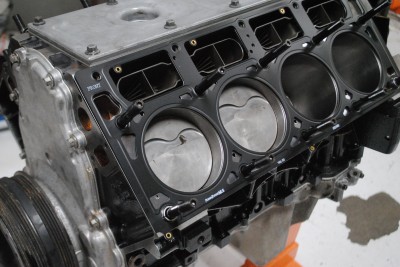
3. The block was bored out from 3.78 to 3.905 inches to make room for a set of JE forged, flat-top pistons. The JE pistons featured valve reliefs to accept our high-lift Crane cam.
In addition to being plenty strong, the JE pistons featured sufficient valve reliefs for our Crane hydraulic roller cam. The Crane cam offered .624 lift, a 232/240-degree duration split and 113-degree lsa. Crane also supplied the hydraulic roller lifters, double roller timing chain and a set of hardened pushrods.
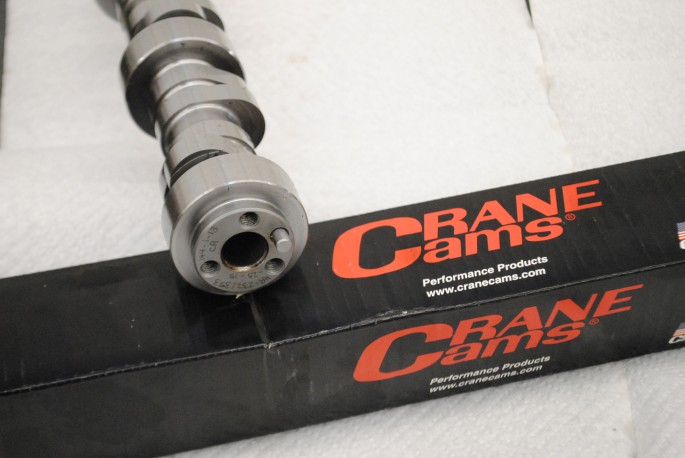
Crane supplied our turbo-friendly hydraulic roller cam that offered .624 lift, a 232/240-degree duration split and 113-degree lsa.

The Crane cam was installed in the awaiting block. Part of the machining operations done at L&R included new cam bearings.

The cam was secured using a new double roller timing chain and fresh oil pump. We used the supplied spacers to provide the necessary oil pump clearance.
The cylinder heads are one of the key ingredients to maximizing airflow through the motor. They also play a key role in sealing the cylinder pressure under boost, as the factory castings have been known to distort under high boost. Wanting to kill two birds with one CNC-ported aluminum stone, we put in a call to Trick Flow Specialties who offered up a set of their Trick Flow GenX 225 heads. What was special about the GenX 225 heads, you ask? How about revised valve angles (from 15-13.5 degrees), full CNC porting and altered spark plug locations. Not enough? How about premium, high-resolution surface finish, fortified rocker-arm mounting pads and increased rigidity for extreme horsepower applications (like ours)! The heads also featured a premium 2.055/1.46 valve package, double springs with sufficient coil bind clearance and spring rate for our .624-lift cam and even titanium retainers to maximize rpm capability. How do they flow? How does over 330 cfm grab you? Knowing we had more cylinder head than our motor could use, the GenX 225 heads were secured to the 383 short block using a set of ARP head studs and Fel Pro MLS head gaskets.
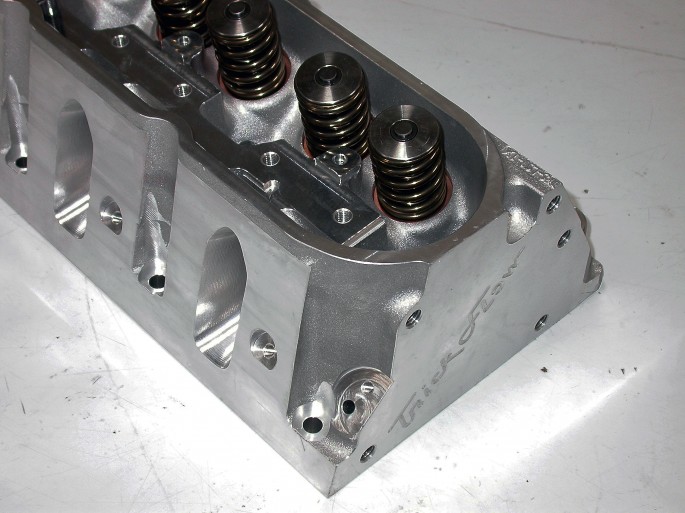
Head flow is one of the key elements in power production so we selected a set of CNC-ported GenX 225 heads from Trick Flow Specialties.

The GenX heads featured dual valve springs for use with our high-lift Crane cam. The spring package included titanium retainers to increase rpm potential.
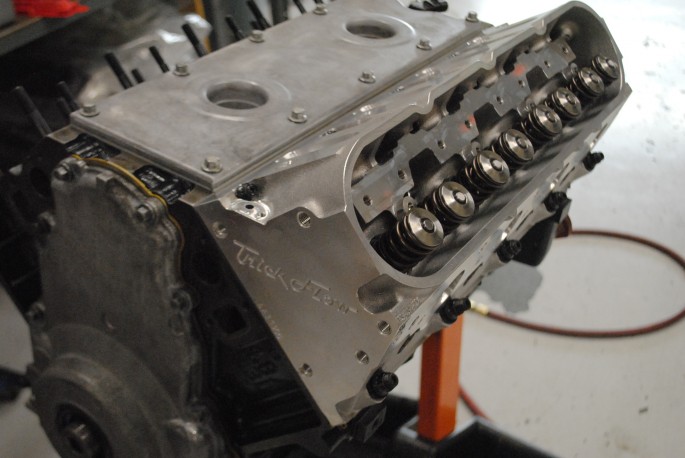
The Gen X 225 heads were secured to the awaiting short block with a set of ARP head studs and Fel Pro MLS head gaskets.
The crowning glory of the 383 stroker was the induction system. Though we started our dyno session with a simple carburetor and single-plane intake, we finished off strong with a Holley EFI LS Mid Ram intake system. Chalk full of cool, the Holley intake was a convertible, meaning it could go topless.
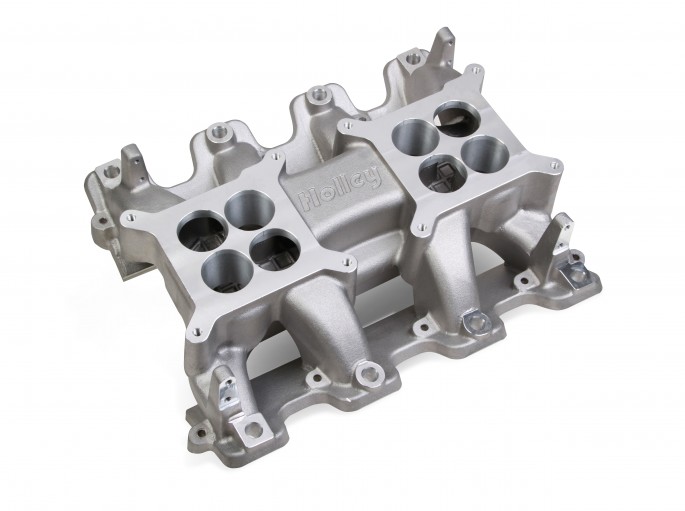
The trick, dual-quad Holley Mid Ram intake was convertible, meaning it could be run carbureted or injected.
Actually, convertible here meant it cold be converted into a different design by removing and/or replacing the top. It was possible to run the Mid Ram with a pair of carburetors, with a pair of 4150-based, four-hole throttle bodies and injectors or (like we did) with a single throttle body and injectors. It is also possible to fabricate a top to suit your individual performance needs. It is this versatility that helped the convertible (baby Snuffleupagus) score high on the old Bangshift cool scale.

Converting the Mid Ram from dual-quad carb mode to single-throttle body EFI mode was a simple matter of installing the adapter and upper throttle body sections.

Holley also supplied the necessary billet fuel rails which we combined with a set of Fast 36-pound injectors for the NA motor.
The Mid Ram intake was combined with the billet fuel rails, 36-pound injectors and a 102-mm Fast throttle body. Controlling all this madness was a Holley Dominator EFI system and Aeromotive fuel system (A1000 fuel pump and fuel pressure regulator). Lack of fuel is not a desirable situation on a high-boost turbo application, so we were glad the Aeromotive products were present and accounted for.

The intake was teamed with a Holley 750 Ultra HP carburetor and MSD ignition controller. The carbureted combo produced 504 hp and 479 lb-ft of torque.
To start off, we set up the 383 with a carbureted induction system and MSD ignition controller. The 383 was equipped with an Edelbrock Victor Jr. intake and Holley 750 Ultra HP carburetor. Additional components included a set of 1 ¾-inch, long-tube headers, a Meziere electric water pump and complete Milodon oiling system including oil pan, windage tray and dip stick.
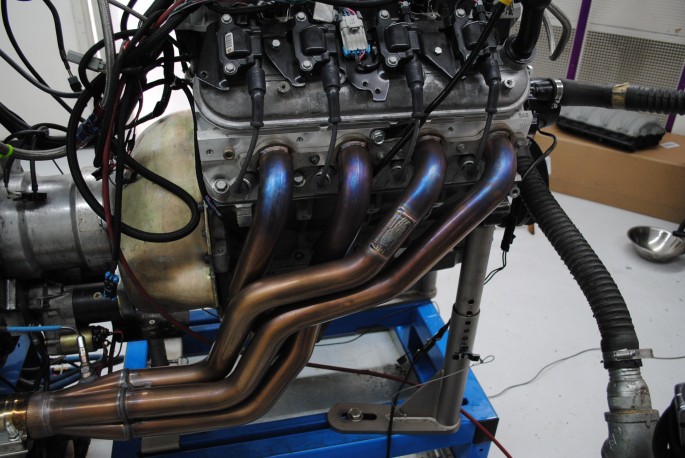
The initial testing was run with a set of 1 ¾-inch, long-tube headers feeding a pair of dyno mufflers.
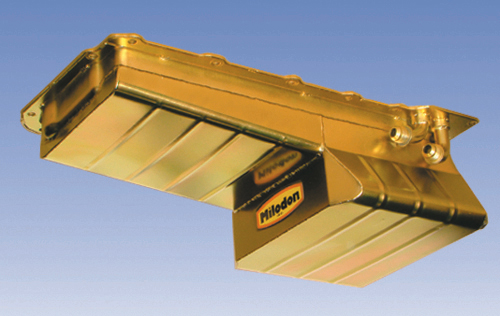
Our Milodon Oil Pan was designed for a remote filter, and came with the windage tray, pump pickup, and dipstick. We’ll show you the mods for the turbo oil return in Part II of the build.
Prior to installation, we added washers to the windage tray studs to provide clearance for the stroker crank and then welded an oil drain fitting (for the turbo) on the pan. Though it was not employed on the normally aspirated testing, it would come into play once we added boost from the single F-body turbo kit from CXRacing. The Milodon pan was first filled with break-in oil from Lucas Oil and a new K&N oil filter then run through a pair of break-in cycles to let the rings and bearings get a chance to get acquainted with their respective surfaces. After the break in procedure and some timing and jetting, we were rewarded with peak numbers of 504 hp and 479 lb-ft of torque. Since we were looking to reach the absurd goal of 1,000 hp, we were already half way there.
Off to a good start with the carburetor, we decided it was time to install the Holley Mid Ram induction and Dominator management system. A simple intake swap, we were up and running in no time and with but a few key strokes, the experts at Westech performance had the stroker up and purring like a kitten in no time. (The injected motor started the first time we hit the starter button by the way). With safety a priority, we kept timing at a minimum until getting a handle on the air/fuel mixture then slowly added timing. What we expected and was immediately obvious was that (like a dual plane intake) the Holley Mid Ram was going to offer more low-speed torque than the single-plane intake. What was surprising was that not only did the Mid Ram better the single-plane down low, but that advantage remained through the entire rev range. When all was said and done, the Mid-Rammed 383 produced 517 hp and 483 lb-ft of torque.
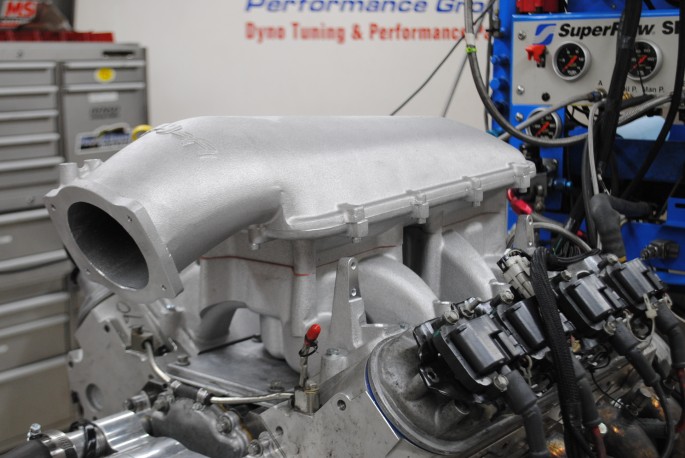
After installation of the Holley Mid Ram EFI intake, the power numbers jumped to 517 hp and 483 lb-ft of torque.
A review of the dyno graphs reveals that the Mid ram was the clear intake choice for this 383. Now that all the atmospheric testing was down, it was time for some boost. Check back with us next time when we run not one but three different turbos in our quest for the Cool G.

Despite being designed for turbo use, the 383 stroker produced impressive power in normally aspirated trim. We first ran the test motor with a simple Edelbrock Victor Jr. intake and 750 HP Holley carb. So equipped, it produced 504 hp and 479 lb-ft of torque. Stepping up to the Holley short-ram intake and Dominator EFI system resulted in a jump in peak power to 517 hp and 483 lb-ft of torque. We were now slightly more than half way to reaching our goal of 1,000 hp.

Here is a little turbo teaser for the next installment. 500-hp 383 plus single turbo and air-to-water intercooler equal big power. We’ll also have cool video, including us goofing off and glowing red turbo headers!
Parts Sources:
Aeromotive
(913) 647-7300 Aeromotiveinc.com
Crane Cams
866-388-5120 www.cranecams.com
CXRacing
(626) 575-3288 CXRacing.com
FAST
(877) 334-8355 www.fuelairspark.com
JE Pistons
714-898-9763 www.jepistons.com
Holley/Hooker
270 782-2900 www.holley.com
Lucas Oil
Milodon
805 577-5950 www.milodon.com
MSD
915 857-5200 MSDPerformance.com
ProComp Electronics
(909) 605-1123 www.procompelectronics.com
Trick Flow Specialties
(330) 630-1555 www.trickflow.com









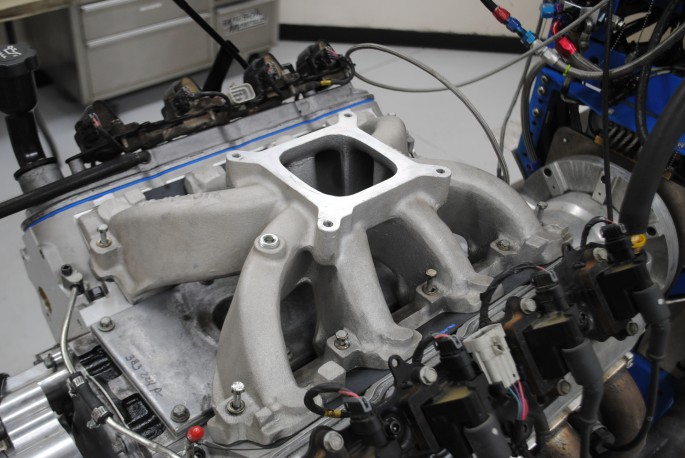
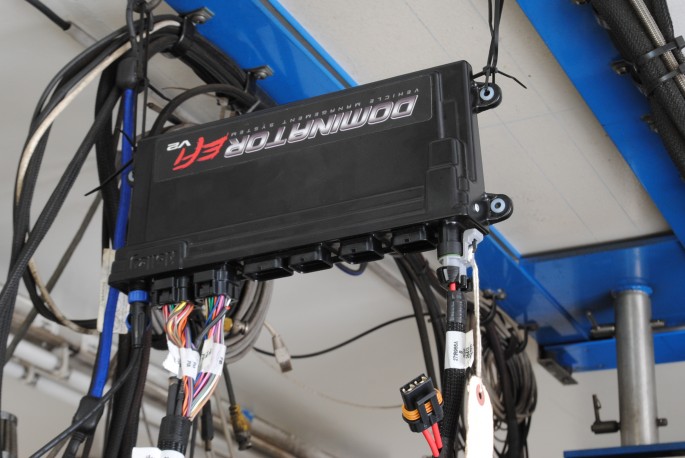





so is Holdener gonna be doing bits here or is this going into Rusty or? ? ?
Yes, Richard is going to be doing some stuff with us around here on occasion. No it’s not going into Rusty. This engine is going into my dad Walt’s Chevy II for Drag Week.
I’ll get more into that part of it in Part 2 of the engine build.
That is going to be seriously bad ass!
whay are there not all weirder looking
WOW
Please bring it to my house so we can put it in the Malibu wagon, I only got shoes for Christmas!
Never mind the wagon, this needs to go into my 95 Caprice! 4-door madness!
I was hoping you were going to say you were looking for an LSR car to test it in. i’m looking for a 1000hp setup to borrow.
Looks good although 36 lb injectors sound a little small for 1000hp
Thank You! Yes the engine build is cool………but thank you thank you for actually DOING something with it after. Please report the chapters as it comes together. It’ll be the highest read segment on Bangshift ever. Mark my words……….
Steve weim55 Colorado
Hey, make sure Chad’s beard doesn’t get too close to that turbo intake….
i’m anxious to see where %100 DC on the injectors is as well! this should go in Buford T. Justice and go to drag week!
“chock full” not chalk
what size injectors when it was turbo’d????